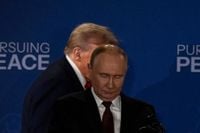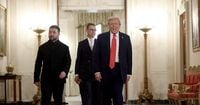In a week marked by sharp rhetoric, deadly escalations, and elusive peace prospects, President Donald Trump’s stance on the ongoing Russia-Ukraine war has once again thrust the conflict into the global spotlight. On August 21, 2025, Trump took to his favored platform, Truth Social, to lambast his predecessor Joe Biden’s approach to Ukraine, accusing him of handicapping Kyiv’s ability to fight back against Russia’s invasion. “It is very hard, if not impossible, to win a war without attacking an invaders country,” Trump wrote, likening Ukraine to a sports team with “fantastic defense” but no offense. “Crooked and grossly incompetent Joe Biden would not let Ukraine FIGHT BACK, only DEFEND. How did that work out?”
Trump’s comments, delivered with his trademark mixture of bravado and sports analogies, came as Ukraine launched a new wave of drone attacks on Russian oil refineries, including a dramatic overnight strike in Rostov Oblast. The timing was significant: Russia, in turn, unleashed its largest hypersonic missile barrage on Ukraine since President Vladimir Putin met with Trump just days earlier, on August 15. According to Ukrainian officials, Russian attacks on western Ukraine killed one person and wounded multiple others, including 12 in Mukachevo near the borders with Hungary and Slovakia. Poland, alarmed by the scale of the assault, scrambled its warplanes to protect its airspace.
It’s a pattern that has become all too familiar. As Moscow and Kyiv trade aerial attacks, world leaders—including Trump—have repeatedly called for a ceasefire. Yet, the violence has only intensified, with both sides escalating their strikes and diplomatic efforts seemingly running in circles.
Trump’s own position on military support for Ukraine, as reported by The Washington Post and analyzed by the Center for Strategic and International Studies, has been anything but consistent. Military aid to Ukraine under his administration has fluctuated—“on and off, then partially on, then on again, and then increased further,” according to the think tank. In November 2024, Biden authorized Ukraine to use American-made long-range ATACMS missiles to strike deeper into Russia, a move Trump denounced as “very stupid” and “a big mistake” during a December press conference. “I wouldn’t have had him do that,” Trump insisted, while his son Donald Jr. warned that Biden was “ushering in World War III.”
Despite his criticism, Trump has at times entertained the idea of providing Ukraine with long-range weapons. In July 2025, he reportedly asked Ukrainian President Volodymyr Zelensky whether Ukraine could strike Russia’s two largest cities if given such munitions by the United States. Yet, by July 15, Trump publicly reversed course, telling reporters he was not willing to provide those arms. The ambiguity has left allies and adversaries alike guessing about the true direction of U.S. policy under his leadership.
Meanwhile, Ukrainian forces have demonstrated remarkable ingenuity in their efforts to strike back. In June, they launched Operation Spiderweb, a covert assault that saw more than 100 FPV kamikaze drones smuggled into Russia disguised as modular homes. The drones, hidden in wooden containers and delivered by unwitting Russian truck drivers, targeted five airfields across Russia, systematically destroying 41 nuclear bombers in what analysts called a “crushing military blow” to Putin.
Yet, even as Ukraine pushes the boundaries of asymmetric warfare, Trump has questioned whether Kyiv possesses the ability—and the political backing—to strike deeper into Russian territory. According to The Telegraph, Trump bluntly asked Zelensky in a July phone call if his forces could hit Moscow, a question that underscores both the former president’s penchant for directness and the high stakes of the conflict.
Trump’s remarks this week were accompanied by a photo of himself playfully poking Putin in the chest, in a nod to the iconic 1959 image of Richard Nixon confronting Soviet premier Nikita Khrushchev. The message was clear: Trump wants to be seen as a leader unafraid to challenge Russia, even as his administration’s policies remain unpredictable.
On August 18, Trump hosted Zelensky and key European leaders—including European Commission President Ursula von der Leyen, NATO Secretary General Mark Rutte, U.K. Prime Minister Keir Starmer, German Chancellor Friedrich Merz, French President Emmanuel Macron, and Italian Prime Minister Giorgia Meloni—in the Oval Office. The summit, by all accounts, yielded “material outcomes on security guarantees,” presenting a united front to Putin. However, as Nexstar Media noted, such promises have often failed to translate into lasting peace. Putin, for his part, responded with another attack on Kharkiv, killing seven people, including two children.
Putin’s demands remain unchanged: total possession of Russian-occupied territories—Donetsk, Luhansk, Zaporizhzhia, Kherson, and Crimea. Zelensky and his European allies have flatly rejected these terms, insisting on Ukraine’s sovereignty and territorial integrity. The Kremlin, meanwhile, has continued to press its advantage, with Russian casualties now exceeding 1,072,700, a staggering figure that highlights the brutal cost of the war.
Trump, frustrated by the lack of progress, has shifted blame to Zelensky. In a recent post, he stated, “President Zelensky of Ukraine can end the war with Russia almost immediately, if he wants to, or he can continue to fight. Remember how it started. No getting back Obama given Crimea (12 years ago, without a shot being fired!), and NO GOING INTO NATO BY UKRAINE.” The implication: peace is within reach if Ukraine accepts Moscow’s conditions, a stance that has drawn criticism from those who argue it amounts to rewarding aggression.
The security guarantees discussed at the summit include the possibility of NATO-like Article Five U.S. commitments for Ukraine. Yet Ukraine, wary after the 1994 Budapest Memorandum—which promised security in exchange for nuclear disarmament but failed to prevent Russia’s 2022 invasion—now demands legally binding treaties. As NATO Secretary-General Mark Rutte told Fox News, “All the details have to be hammered out.”
Trump has categorically ruled out sending U.S. troops to Ukraine, a position echoed by the Kremlin’s rejection of NATO forces on the ground. While Trump has suggested he might consider providing U.S. pilots and warplanes as part of security guarantees, direct engagement with Russian aircraft remains highly unlikely except in self-defense scenarios.
Putin’s calculus, as many analysts observe, is not measured in human lives but in strategic advantage. As long as Moscow believes it can gain from continued conflict, peace will remain elusive. “You’re not going to end a war between Russia and Ukraine without dealing with Putin,” U.S. Secretary of State Marco Rubio said on ABC News. Yet, as the cycle of violence continues, many wonder when—if ever—the fighting will end.
For now, the war grinds on, with each escalation met by another, and peace as distant as ever. The world watches, hopeful for a breakthrough, but bracing for whatever comes next.





